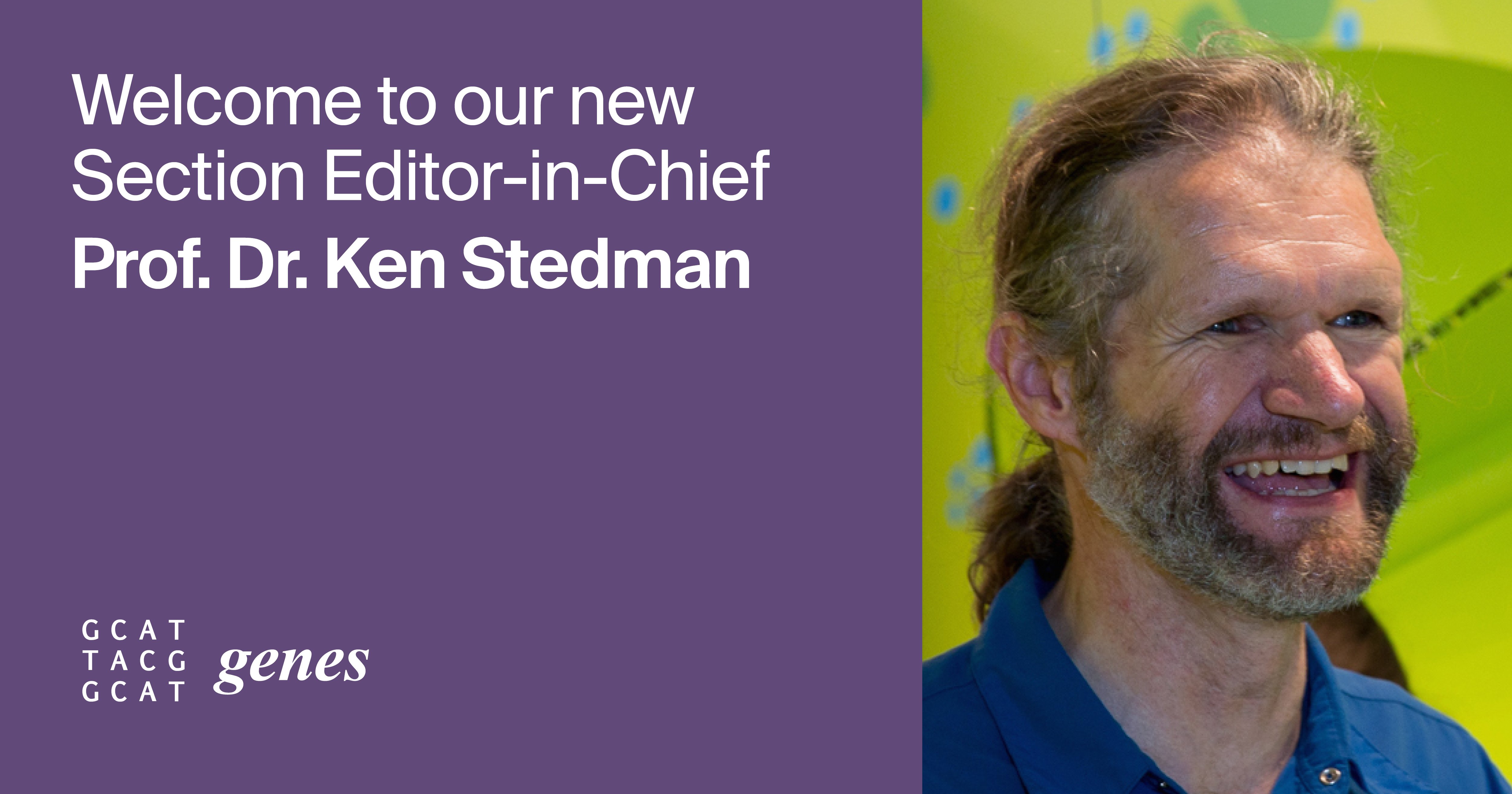
Journal Menu
► ▼ Journal Menu-
- Genes Home
- Aims & Scope
- Editorial Board
- Reviewer Board
- Topical Advisory Panel
- Instructions for Authors
- Special Issues
- Topics
- Sections & Collections
- Article Processing Charge
- Indexing & Archiving
- Editor’s Choice Articles
- Most Cited & Viewed
- Journal Statistics
- Journal History
- Journal Awards
- Society Collaborations
- Conferences
- Editorial Office
Journal Browser
► ▼ Journal BrowserNeed Help?
Announcements
24 November 2025
Prof. Dr. Ken Stedman Appointed Section Editor-in-Chief of Section “Viral Genomics” in Genes

We are pleased to announce the appointment of Prof. Dr. Ken Stedman as the new Section Editor-in-Chief of the Section “Viral Genomics” in Genes (ISSN: 2073-4425).
Prof. Dr. Ken Stedman is a Professor at Portland State University, where he conducts research at the Center for Life in Extreme Environments, Department of Biology. He has been teaching and performing research on extreme viruses at Portland State University since 2001. His research focuses on the structure, function, biochemistry, evolution, and genetics of viruses in extreme environments. Recently, his research has expanded into vaccine stabilization.
Prof. Dr. Stedman holds a PhD in molecular and cell biology from the University of California, Berkeley. He is a member of the American Society for Microbiology, American Society for Virology, American Association for the Advancement of Science, Oregon Nanoscience and Microtechnologies Institute, International Society for Extremophiles, Marie Curie Fellowship Association, and the International Society for Microbial Ecology.
The following is a short Q&A with Prof. Dr. Ken Stedman, who shared his vision for the journal with us, as well as his views on the current state of the field:
1. What recent developments in the field of viral genomics do you find most exciting?
I think that virus metagenomics is the area that’s most exciting right now because there are so many new discoveries being made in metagenomes. There are massive numbers of virus metagenomes available, and I believe many of them haven’t been published or analyzed yet. For me, that’s really the most exciting aspect, and I think it represents the future direction of the field.
2. How has your experience been as a member of the Editorial Board, and what motivated you to accept the role of Section Editor-in-Chief?
I’ve been on the board of Genes for a few years, and I didn’t realize there was a Section dedicated to viral genomics. I believe that with my contacts and the role of Section Editor-in-Chief, I can help highlight the vast number of viral metagenomes that are currently hidden away in databases or in my colleagues’ collections. I think that as Section Editor-in-Chief, I would have the opportunity to make these metagenomes more publicly visible, and I believe Genes would be an excellent venue for publishing them.
3. What are your expectations and suggestions for the future growth of our Section and the journal? What is your vision for its development?
My expectations and suggestions are closely tied to viral metagenomics. I would like to bring together a Special Issue on this topic, as I believe this is an area where both the Section and the journal could expand. Genes could be a particularly strong platform for publishing these types of articles, especially since there isn’t a dedicated journal focused on viral metagenomics at this time.
4. What is your perspective on the rise of open access publishing in the academic field? How do you believe it has impacted your area of study, and what potential effects do you foresee it having on your field and science overall in the future?
In the long term, I think open access publishing is a fantastic idea, as it makes science accessible to a much broader community. In the short term, however, I’m a bit concerned about how it will sustain itself, especially in the current funding environment in the U.S. It’s unclear how it will continue to be supported from a resource perspective. I’ve been fortunate to have funding, and I strive to publish open access because I believe it’s the right thing to do.
5. When selecting a journal for publication, what aspects do you value the most?
First and foremost, I’m a big fan of open access and Society journals, so I would choose one of these. It’s not just for me; it’s also for my colleagues. Whether we like it or not, the scientific system we live in values Impact Factors, particularly for younger scientists. When deciding where to publish research that isn’t a huge breakthrough, we specifically aim to publish in journals that we believe will attract a readership interested in our work. A lot of this also depends on the Editorial Board, as they understand the value of what you are trying to publish.
6. What advice or suggestions do you have for emerging scholars in your field?
My main recommendation is always to publish, publish, publish! As one of my colleagues used to say, “If it’s not published, it never happened.” Another piece of advice I give is to try and publish in an open access journal. I often mention to my students that the individual paper’s quality is more important than the journal’s Impact Factor. If it’s a really good paper, it will get cited, especially if it’s open access and accessible to people. Ultimately, it doesn’t matter too much which journal it’s published in.
We wish Prof. Dr. Ken Stedman every success in his new position, and we look forward to his contributions to the journal.




